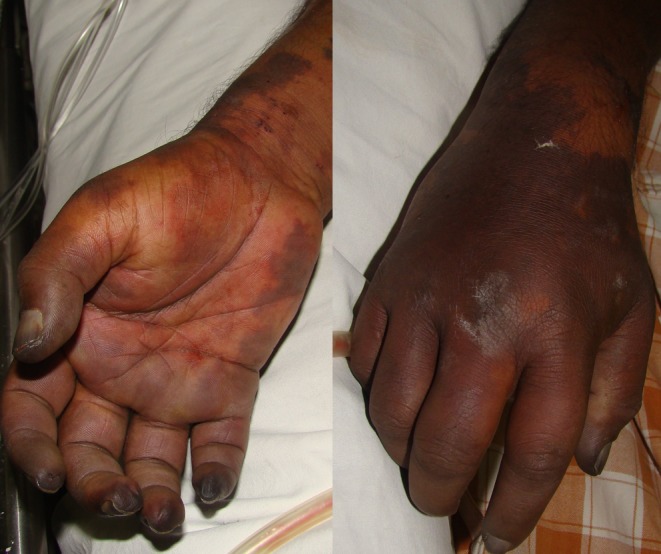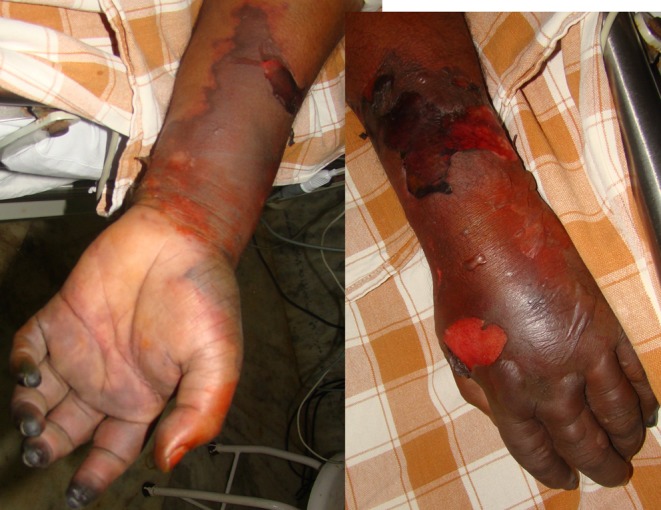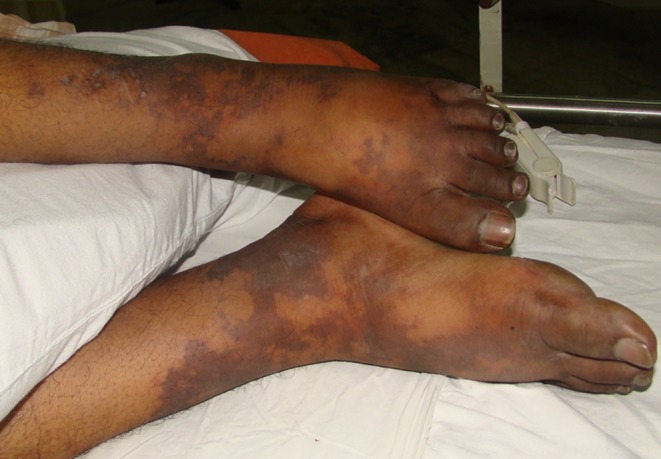Abstract
A 30 year-old gentleman presented to casualty with history of pain abdomen for six days, fever and decreased urine output since two days. He was in a state of septic shock and was diagnosed to have intestinal perforation. His peripheral pulses were not palpable except for the femoral and brachial vessels. Despite fluid resuscitation, he needed infusion of high doses of dopamine and noradrenaline to maintain his blood pressure. He was operated for repair of perforation. On the first postoperative day, in the intensive care unit, vasopressin infusion was added in view of persistent hypotension. Appropriate fluid resuscitation and antibiotic therapy helped to wean him off inotropes and vasopressors by the second postoperative day. On the 3rd postoperative day, however, the patient developed discolouration and blebs on the fingers of left hand, followed by the right hand and then both the lower limbs. Subsequently, over a period of 10 days, this progressed to gangrene formation in the hands despite the patient being haemodynamically stable without any inotropes or vasopressors in this period. We conclude that the septic shock is a systemic derangement affecting all organ systems including coagulation and microcirculation. Early recognition and prompt management of sepsis, optimisation of fluid status to wean off the inotropes and vasopressors at the earliest is necessary to avoid catastrophes such as symmetrical peripheral gangrene.
Keywords: Symmetrical peripheral gangrene, Sepsis, Vasopressors, Multiple arterial punctures, Resuscitation.
Case Report
A 30-year-old man, an agriculturist by occupation, presented to the casualty ward with abdominal pain for 6 days and fever and reduced urine output for 2 days. He was in a state of intense septic shock with absent peripheral pulsations, and the pulse oximeter could not pick up pulsations. Despite fluid resuscitation, he needed high doses of dopamine (20 μg/kg/min) and noradrenaline (0.2–0.3 μg/kg/min) to maintain normotension. The patient was also found to have altered coagulation parameters which were corrected with fresh frozen plasma. An emergency laparotomy revealed jejunal perforation which was closed. The patient was found to have cirrhotic liver (he was a known chronic alcoholic). Blood pressure remained persistently low, requiring addition of vasopressin infusion in the postoperative period. After multiple failed attempts at cannulation of the radial arteries in both upper limbs, a femoral arterial line was secured in the intensive care unit. By the second postoperative day, all the vasopressors were weaned off. However, cyanosis of the extremities was noted. On the third postoperative day, small blebs/blisters were noticed first in the left hand and subsequently in other limbs also which progressed to gangrene formation over the next 1 week (Figs. 1, 2, 3). Doppler evaluation revealed presence of diminished pulsations in all the vessels supplying the limbs. Echocardiogram revealed absence of any septic foci. While we were waiting for a clear demarcation to develop for amputation of gangrene, the patient succumbed to multiorgan failure in the next week.
Fig. 1.

Ischaemic changes in the anterior and posterior aspect of right hand
Fig. 2.

Ischemic changes and blister formation in the left hand
Fig. 3.

Ischaemic changes observed in both feet
Discussion
Septic shock results in a state of low perfusion to peripheries and should be treated aggressively. Long duration of low perfusion pressures might lead to peripheral ischemia. Symmetrical peripheral gangrene is described as multiple extremity ischemia at two or more sites in the absence of large vessel obstruction [1, 2]. Possible etiological factors cited in literature include obstructive intracardiac lesions [3], sepsis [4], vasospastic conditions [5, 6], small vessel obstruction [1], protein C deficiency [7], use of vasopressor agents [8, 9], low cardiac output states [10, 11], disseminated intravascular coagulation (DIC) [12, 13], factor V Leiden mutation [14], and parenteral abuse of the sublingually available form of buprenorphine [15]. It is well established that the digital perfusion will drop to zero in presence of persistently low perfusion pressures of 35–60 mmHg [16]. Frequently cited aggravating factors are diabetes mellitus, cold injury to extremities, renal failure, and use of vasopressors [4]. This condition has a high mortality rate of 40 % [4].
The first line of management, when the perfusion to peripheries is doubtful, should be to resuscitate aggressively with fluids with the aim to discontinue vasopressors as soon as possible [4]. Vigorous therapy of sepsis with intravenous antibiotics and anticoagulation for DIC are the other suggested measures [4, 12]. Sympathetic blockade, intravenous vasodilators, local injection of alpha-blockers, and phosphodiesterase inhibitors have all been attempted after appearance of digital ischemia, but prevention appears to be the best line of management [8, 9, 17–21]. Local debridement and secondary skin grafting have not been shown to be successful, and amputation should be considered only after a clear line of demarcation develops [20].
Symmetrical peripheral gangrene is known to present with pallor or cyanosis, coldness, and pain in the extremity in the initial phases. If appropriate care is not provided at this stage, the digits may progress to become erythematous with dusky discoloration of skin followed by development of bullae or blisters that subsequently result in formation of gangrene [4]. Pulses may be intact in the early stages and large vessels are often spared. Low flow states result in occlusion of the microcirculation of the affected parts [1-5]. This could be aggravated by the use of vasopressors to treat profound hypotension before optimization of fluid status as it would result in even more sluggish flow in the microcirculation [8, 9]. Thus, the symmetric peripheral gangrene occurs due to ischemia caused by a combination of vasospasm and thrombosis. Pathological examination of amputated specimen in fact has been known to have thrombi concentrated in the small vessels with no thrombus in the large vessels [4]. The key to avoiding such a disastrous outcome, therefore, is early recognition and aggressive management of sepsis and other aggravating factors so as to prevent the development of ischemia and gangrene.
The patient that we have reported in this article had septic shock (later confirmed by blood culture reports) at presentation with persistently low blood pressures requiring high doses of vasopressors and had superadded component of DIC. Although any of these could be identified as risk factors for subsequent development of gangrene, a vital point in this patient is that he presented to the casualty ward after a prolonged period of septic shock with reduction in blood flow to distal peripheries as evidenced by absence of peripheral pulses and inability of pulse oximeter to detect pulsations. It is difficult to ascertain if liver cirrhosis contributed to this. Although the gangrenous changes were observed in all four limbs, earlier appearance in the upper limbs could have been contributed by multiple arterial punctures attempted at both the radial arteries.
We conclude that the septic shock is a systemic derangement affecting all organ systems including coagulation and microcirculation, resulting hypoperfusion to peripheries. Awareness, early recognition, and prompt management of this condition are necessary to avoid catastrophes such as symmetrical peripheral gangrene. Coagulation parameters should also be monitored and derangements should be promptly corrected. When a patient needs to be on vasopressors and inotropes, care should be taken to optimize the fluid status (in accordance with surviving sepsis guidelines). Vasopressors should be withdrawn as early as possible, especially in the presence of any coldness and discoloration in the extremity. Caution should be exercised in performing arterial punctures as this might hasten the ischemia.
References
- 1.Goodwin JN, Berne TV. Symmetrical peripheral gangrene. Arch Surg. 1974;108:780–784. doi: 10.1001/archsurg.1974.01350300022006. [DOI] [PubMed] [Google Scholar]
- 2.Hutchison J. Symmetrical gangrene of the extremities. Br Med J. 1891;2:8–9. doi: 10.1136/bmj.2.1592.8. [DOI] [Google Scholar]
- 3.McGouran RCM, Emmerson GA. Symmetrical peripheral gangrene. Br Heart J. 1977;39:569–572. doi: 10.1136/hrt.39.5.569. [DOI] [PMC free article] [PubMed] [Google Scholar]
- 4.Parmar MS. Symmetrical peripheral gangrene: a rare but dreadful complication of sepsis. CMAJ. 2002;167:1037–1038. [PMC free article] [PubMed] [Google Scholar]
- 5.Raynaud M (1888) On local asphyxia and symmetrical gangrene of the extremities. Translated by Thomas Barlow. In: Selected monographs. New Sydenham Society, London, pp 1–199
- 6.Cranley JJ, Krause RJ, Strasser ES, Hafner CD. Impending gangrene of four extremities secondary to ergotism. N Engl J Med. 1963;269:727–729. doi: 10.1056/NEJM196310032691404. [DOI] [PubMed] [Google Scholar]
- 7.Pulkki LM, Pettila V, Rasi V, et al. Protein C substitution in sepsis-associated purpura fulminans. Crit Care Med. 2000;7:2373–2378. doi: 10.1097/00003246-200007000-00032. [DOI] [PubMed] [Google Scholar]
- 8.Hayes MA, Yau EH, Hinds CJ, Watson JD. Symmetrical peripheral gangrene: association with noradrenaline administration. Int Care Med. 1992;18:433–436. doi: 10.1007/BF01694349. [DOI] [PubMed] [Google Scholar]
- 9.Joynt G, Doedens L, Lipman J, Bothma P. High-dose adrenalin with low systemic vascular resistance and symmetrical peripheral gangrene. S Afr J Surg. 1996;34:99–101. [PubMed] [Google Scholar]
- 10.Abrahams DG. Incipient symmetrical peripheral gangrene complicating paroxysmal tachycardia. Br Heart J. 1948;10:191–194. doi: 10.1136/hrt.10.3.191. [DOI] [PMC free article] [PubMed] [Google Scholar]
- 11.Swan WGA, Henderson CB. Peripheral gangrene in myocardial infarction. Br Heart J. 1951;13:68–73. doi: 10.1136/hrt.13.1.68. [DOI] [PMC free article] [PubMed] [Google Scholar]
- 12.Molos MA, Hall JC. Symmetrical peripheral gangrene and disseminated intravascular coagulation. Arch Dermatol. 1985;121:1057–1061. doi: 10.1001/archderm.1985.01660080111027. [DOI] [PubMed] [Google Scholar]
- 13.Ghosh SK. Symmetrical peripheral gangrene. Dermat Venereol. 2010;24(2):214–218. doi: 10.1111/j.1468-3083.2009.03329.x. [DOI] [PubMed] [Google Scholar]
- 14.Jackson RT, Luplow RE. Adult purpura fulminans and digital necrosis associated with sepsis and the factor V mutation. JAMA. 1998;280:1829. doi: 10.1001/jama.280.21.1829. [DOI] [PubMed] [Google Scholar]
- 15.Loo HW, Yam AKT, Tan TC, Peng YP, Teoh LC. Severe upper limb complications from parenteral abuse of Subutex®. Ann Acad Med Singapore. 2005;34:575–578. [PubMed] [Google Scholar]
- 16.Roddie IC, Shepherd JT. Evidence for critical closure of digital resistence vessels with reduced trauismural pressure and passive dilatation with increased venous pressure. J Physiol. 1957;136:498–506. doi: 10.1113/jphysiol.1957.sp005776. [DOI] [PMC free article] [PubMed] [Google Scholar]
- 17.Stossal TP, Levy R. Intravascular coagulation associated with pneumococcal bacteriemia and symmetrical peripheral gangrene. Arch Intern Med. 1970;125:876–878. doi: 10.1001/archinte.1970.00310050114014. [DOI] [PubMed] [Google Scholar]
- 18.Johnson K, Hansen ST., Jr SPG (purpura fulminans) complicating pneumococcal sepsis. Am J Surg. 1993;165:642–645. doi: 10.1016/S0002-9610(05)80452-0. [DOI] [PubMed] [Google Scholar]
- 19.Coakley J. Nitroglycerin ointment for dopamineinduced peripheral ischaemia [letter] Lancet. 1983;2:633. doi: 10.1016/S0140-6736(83)90723-7. [DOI] [PubMed] [Google Scholar]
- 20.Leaker B, Miller R, Cohen S. Treatment of acute renal failure, symmetrical peripheral gangrene, and septicaemia with plasma exchange and epoprostenol [letter] Lancet. 1987;1:156. doi: 10.1016/S0140-6736(87)91983-0. [DOI] [PubMed] [Google Scholar]
- 21.Kumana CR, Cheung GTY, Lau CS. Severe digital ischaemia treated with phosphodiesterase inhibitors. Ann Rheum Dis. 2004;63:1522–1524. doi: 10.1136/ard.2003.015677. [DOI] [PMC free article] [PubMed] [Google Scholar]


